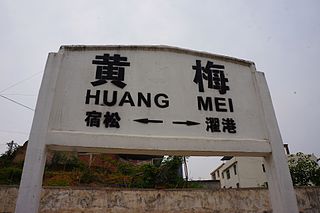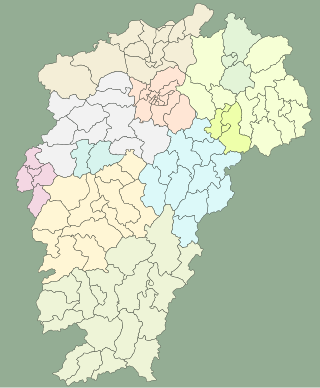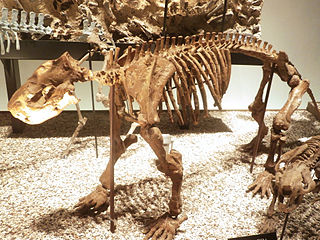
Jiangxi is an inland province in the east of the People's Republic of China. Its major cities include Nanchang and Jiujiang. Spanning from the banks of the Yangtze river in the north into hillier areas in the south and east, it shares a border with Anhui to the north, Zhejiang to the northeast, Fujian to the east, Guangdong to the south, Hunan to the west, and Hubei to the northwest.

Jingdezhen is a prefecture-level city, in northeastern Jiangxi province, with a total population of 1,669,057 (2018), bordering Anhui to the north. It is known as the "Porcelain Capital" because it has been producing Chinese ceramics for at least 1,000 years, and for much of that period Jingdezhen porcelain was the most important and finest quality in China. The city has a well-documented history that stretches back over 2,000 years.

Nanchang is the capital of Jiangxi Province, China. Located in the north-central part of the province and in the hinterland of Poyang Lake Plain, it is bounded on the west by the Jiuling Mountains, and on the east by Poyang Lake. Because of its strategic location connecting the prosperous East and South China, it has become a major railway hub in Southern China in recent decades.

Huanggang is a prefecture-level city in easternmost Hubei Province, China. It is situated to the north of the middle reaches of the Yangtze River and is bounded in the north by the Dabie Mountains and is named after Mount Huanggang. It borders Henan in the north, Anhui in the east and Jiangxi in the south.

Huangmei County falls under the administration of Huanggang City in eastern Hubei province, People's Republic of China, and borders Anhui to the east and Jiangxi to the south across the Yangtze. It also administers Shanjia Islet (单家洲) in the Yangtze.

Jiangxi cuisine, also known as Gan cuisine, is a style of Chinese cuisine derived from the native cooking styles of Jiangxi province in southern China. According to the East China Travel Guide published in 1983, Jiangxi cuisine has its unique taste which can be described in four Chinese idioms: 原汁原味(aim to bring out the own flavor of the cooking material),油厚不腻(dishes contained a significant amount of oil but the taste are not greasy),口味浓厚(dishes have really thick taste),咸鲜兼辣(always come with spicy solid, salty flavor). Jiangxi cuisine is widely popular within the ordinary family because most of the notable dishes from Jiangxi cuisine are the extension of homely dishes with solid local flavor.
Liu Cong was a Chinese politician who lived during the late Eastern Han dynasty of China. He was the younger son of Liu Biao, the Governor of Jing Province.

Jiangxia District is one of 13 urban districts of the prefecture-level city of Wuhan, the capital of Hubei province, China, situated on the eastern (right) bank of the Yangtze River. Jiangxia district has an area of 2,009 square kilometres (776 sq mi) and a population of 680,000. It is the southernmost and most sparsely populated of Wuhan's districts. It borders the districts of Caidian and Hannan across the Yangtze and Hongshan to the north, as well as the prefecture-level cities of Ezhou to the east, Huangshi to the southeast, and Xianning to the south.
Wang Sengbian, courtesy name Juncai (君才), was a Chinese military general and regent of the Liang dynasty. He came to prominence as the leading general under Emperor Yuan 's campaigns against the rebel general Hou Jing and other competitors for the Liang throne, and after Emperor Yuan was defeated by Western Wei in 554 and killed around the new year 555 became the de facto regent over the remaining provinces of Liang. He made Xiao Yuanming the Marquess of Zhenyang, a cousin of Emperor Yuan and a candidate for the throne favored by Northern Qi, emperor, but four months later, his subordinate Chen Baxian carried out a coup, killing him and deposing Xiao Yuanming.
The Battle of Xiakou was fought between the warlords Sun Quan and Liu Biao in 203 in the late Eastern Han dynasty. Sun Quan's forces attempted to conquer Jiangxia Commandery, which was defended by Liu Biao's general, Huang Zu. The battle was inconclusive as Sun Quan's forces were unable to capture Jiangxia even when Huang Zu retreated. The battle is not to be confused with the Battle of Jiangxia that took place five years later, which concluded with victory for Sun Quan over Huang Zu.

Mesonychidae is an extinct family of small to large-sized omnivorous-carnivorous mammals. They were endemic to North America and Eurasia during the Early Paleocene to the Early Oligocene, and were the earliest group of large carnivorous mammals in Asia. Once considered a sister-taxon to artiodactyls, recent evidence now suggests no close connection to any living mammal. Mesonychid taxonomy has long been disputed and they have captured popular imagination as "wolves on hooves", animals that combine features of both ungulates and carnivores. Skulls and teeth have similar features to early whales, and the family was long thought to be the ancestors of cetaceans. Recent fossil discoveries have overturned this idea; the consensus is that whales are highly derived artiodactyls. Some researchers now consider the family a sister group either to whales or to artiodactyls, close relatives rather than direct ancestors. Other studies define Mesonychia as basal to all ungulates, occupying a position between Perissodactyla and Ferae. In this case, the resemblances to early whales would be due to convergent evolution among ungulate-like herbivores that developed adaptations related to hunting or eating meat.

Yantanglestes is a genus of small, Chinese mesonychid with slender jaws that first appeared during the Early Paleocene in the Thanetian stage. It was found throughout Asia. It is the oldest known mesonychid. Yantanglestes became extinct during the Nongshanian division of the Late Paleocene, and lived sympatrically with its descendant genera, including Dissacus, Sinonyx and Jiangxia.
Jingzhou or Jing Province was one of the Nine Provinces of ancient China referenced in early Chinese texts such as the Tribute of Yu, Erya, and Rites of Zhou.

Bemalambdidae is an extinct family of pantodont mammals known from Early and Middle Paleocene of China.
Yao Mugen is a former Chinese politician from Jiangxi province. He served as Vice-Governor of Jiangxi from 2011 to 2014, and prior to that Chairman of the Jiangxi Development and Reform Commission, a provincial body with broad powers over the economy. He was removed from his posts and investigated by the Central Commission for Discipline Inspection in March 2014.
Jiangxi Air Co., Ltd. is a Chinese low-cost carrier with its headquarters at Nanchang Changbei International Airport, Jiangxi. It is a joint venture between XiamenAir and the Jiangxi Provincial Government. The airline flies to six destinations using Boeing 737-800 aircraft.
Jiangxia Commandery was a Chinese commandery that existed from Han dynasty to Tang dynasty. Its territories were located in present-day eastern Hubei province.

Wuhandong railway station, formerly known as Liufang railway station, is a railway station located in Jiangxia District, Wuhan, Hubei Province, China. The new railway station opened on August 12, 2022. It is served by Line 2 and Line 11 of the Wuhan Metro.

Bemalambda is an extinct mammal, belonging to the pantodonts. It lived in the lower-middle Paleocene and the fossil remains have been found in China.












